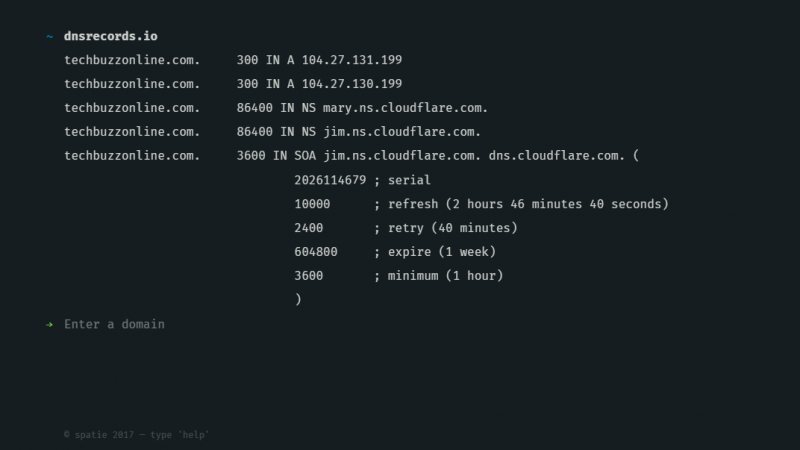How to Check DNS Records of a Domain
If you have a website, then you may have the need to lookup that your domain is correctly pointing to your web-server or not, and whether the MX records or the CNAME records have been correctly configured on not.
Alternatively, you may also need to lookup the DNS records of other domains. In this article, we show you how you can easily check DNS records using command line or using free online tools.
 DNS Records of TechBuzzOnline.com
DNS Records of TechBuzzOnline.com
Types of DNS Records
There are many different types of DNS records and you can see a full list on Wikipedia. Presented below are the top 6 most prominent DNS records which are used with a domain name and are often queried using DNS tools.
- A Record : The ‘A’ record specifies the IP address (IPv4) of a host. This record is used to map hostnames to an IP address of the host.
- AAA Record : The ‘AAA’ record specifies the IP address (IPv6) of a host.
- NS Record : NS Record stands for Name Server record and it maps a domain name to a list of authoritative Name servers.
- MX Record : An MX record maps a domain name to a list of mail exchange servers.
- CNAME Record : CNAME record stands for Canonical Name and is used to create aliases that point to other names/sub-domains such as www, ftp, mail etc.
- TXT Record : A TXT record can provide text information to sources outside your domain. This information can either be human-readable or machine-readable and is often used for verifying ownership of domain to external services.
Check DNS Records Using Command Line
The best way to check DNS records is to use a terminal and run the command nslookup on the command line. This command will run on almost all operating systems including Linux, MacOS and Windows. Find below the command to check various DNS record types using the nslookup command.
We are using our domain name techbuzzonline.com for demonstrating the use of the command. Please make sure to replace the domain with the domain you want to look DNS records for.
Lookup ‘A Record’
nslookup -type=A techbuzzonline.comLookup ‘NS Record’
nslookup -type=NS techbuzzonline.comLookup ‘MX Record’
nslookup -type=MX techbuzzonline.comLookup ‘CNAME Records’
nslookup -type=CNAME techbuzzonline.comLookup ‘TXT Records’
nslookup -type=TXT techbuzzonline.comExample Output:
# nslookup -type=CNAME techbuzzonline.com
Server: XiaoQiang
Address: 192.168.31.1
techbuzzonline.com
primary name server = jim.ns.cloudflare.com
responsible mail addr = dns.cloudflare.com
serial = 2026114679
refresh = 10000 (2 hours 46 mins 40 secs)
retry = 2400 (40 mins)
expire = 604800 (7 days)
default TTL = 3600 (1 hour)Check DNS Records Using Online Tools
If using the command line appears to be difficult for you then you can make use of one of the many trusted online tools that can help you check DNS records of a domain. Find below the best 3 such online tools which make checking DNS records of a domain available online:
Google Public DNS
This is the official DNS checking tool by Google and and be used to easily check DNS records of a domain or IP address. Simply enter the domain name in the field provided and Google will present ‘A’ records of the domain by default. You can change the record type to ‘AAA’, ‘CNAME’, ‘MX’ or ‘ANY’ using the buttons provided.
The results are presented in an unique URL which makes it easy to share or link to. for example here is the link to DNS records of techbuzzonline.com
DNSRecords.io
This is the simplest online tool to check DNS records of a domain name. Just enter the domain and it will fetch all DNS records associated with it. The results are presented in a unique URL and thus can be shared and linked to. For example, here are the DNS records of our site.
Dig Web Interface
Dig Web Interface is an online tool to make advanced DNS lookups such as reverse domain lookup, domain name comparison and a lookup of almost all types of domain records.
We hope our article was helpful in letting you understand how a DNS record can be checked for a website or domain. We have tried to cover both the command line lookup as well as use of online DNS tools. You may also be interested in taking a look at these website competitor analysis tools which can help you in finding out many information about a domain including its traffic, hosting provider, top search terms etc.
Also don’t forget to read our article about using Google DNS which can boost your own network latency.

